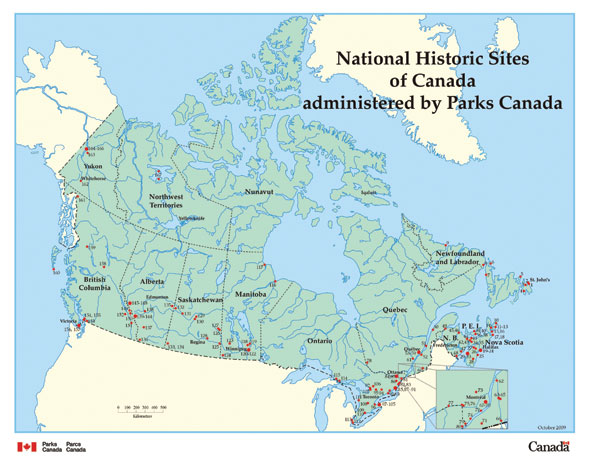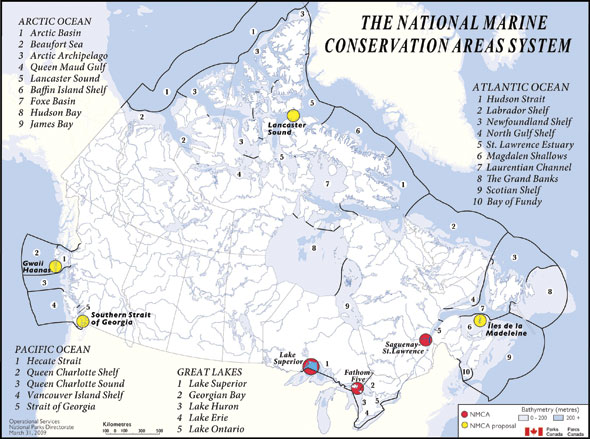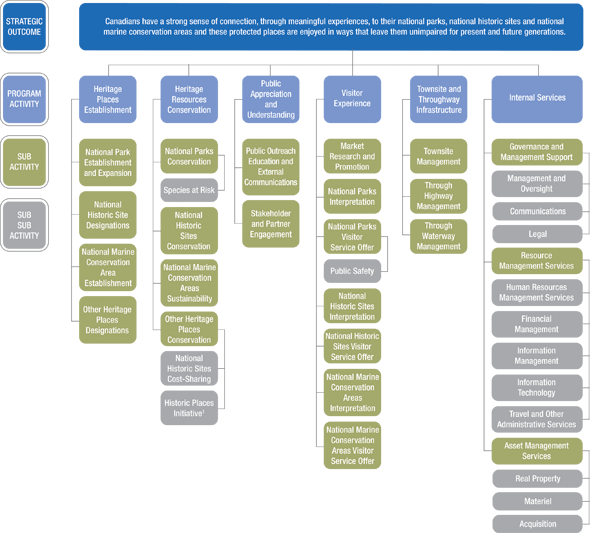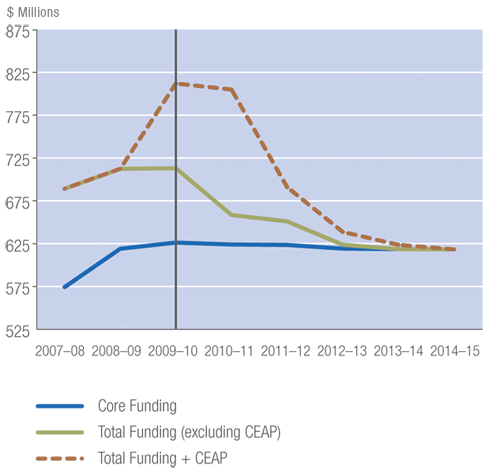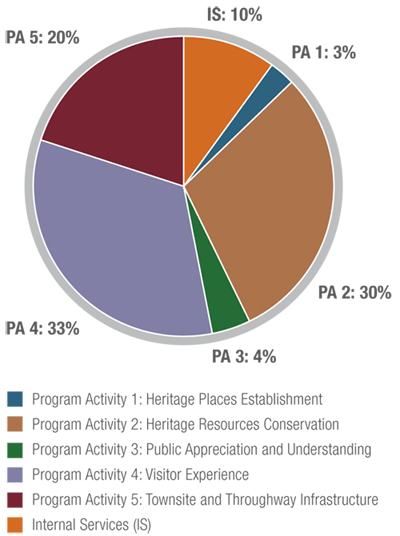Common menu bar links
Breadcrumb Trail
ARCHIVED - Parks Canada
 This page has been archived.
This page has been archived.
Archived Content
Information identified as archived on the Web is for reference, research or recordkeeping purposes. It has not been altered or updated after the date of archiving. Web pages that are archived on the Web are not subject to the Government of Canada Web Standards. As per the Communications Policy of the Government of Canada, you can request alternate formats on the "Contact Us" page.
Minister's Message

Canadians live in a country full of opportunities. As Minister responsible for Parks Canada, I am particularly proud of the opportunities we have to ensure that our generation can leave our children a legacy of indispensable benefits of iconic wildlife, fascinating historic places, and clean water. The year 2010, in addition to being the International Year of Biodiversity, marks the 125th anniversary of the creation of Canada's first national park and the world's third protected area, and next year, Parks Canada will celebrate its 100th anniversary. These celebrations bring greater attention to the importance of protecting biodiversity around the world.
Parks Canada is at work across the country-wide network of national parks, national historic sites and national marine conservation areas to provide world-class conservation as well as opportunities for Canadians to learn about and have extraordinary experiences of discovery at these national treasures. This is the future we foresee, and to achieve it, we rely on science, long-term vision, dedicated employees and partners.
In fact, we have already started putting measures in place to ensure the success our planned actions. For example, we have plans to enhance the protection of heritage areas in places like Mealy Mountains, Lancaster Sound and Gwaii Haanas. We are currently conducting feasibility studies, consultations and negotiations in exceptional places across Canada. We have put in place measures to track the health of our national parks, with an ultimate goal of helping wildlife populations to recover, and protecting and restoring coastlines and improving waterways. We are working at connecting Canadians to their wilderness and heritage places. We are encouraging more people to rediscover their nature and their history.
Finally, we will build on our strong partnerships with Aboriginal peoples, other levels of government, the private sector, nongovernmental organizations, environmental groups and concerned citizens. I recently had the chance to share thoughts with several stakeholders representing the broad spectrum of Canadian society at the Fifth Minister's Round Table on Parks Canada, in Toronto. Parks Canada's priorities and planned activities identified in this Corporate Plan reflect those discussions.
While our wild areas are allies in the race against climate change, our protected natural and historic heritage places are fundamental elements of Canada's tourism industry and economic generators. We have a true gem in our hands and it is our mission to pass it on to future generations. We have a responsibility to take action. I hope that the actions we are taking today will also serve to inspire our children – the leaders of tomorrow – to get involved in the preservation and presentation of Canada's history and natural treasures.
We are making a difference. We are working together to create the landscape of possibilities for our future generations.
Paper copy signed byThe Honourable Jim Prentice, P.C., Q.C., M.P.
Minister of the Environment and Minister responsible for Parks Canada Agency
Chief Executive Officer's Message

This Corporate Plan is very special because it marks the celebration of more than one century of heritage conservation leadership in the world and 125 years of national parks. Every year, as I reflect on the challenges and opportunities ahead to set goals for the Agency, I reflect on how far we have come since the last Corporate Plan. For this special issue, I take stock of how far we've progressed since the establishment of Banff National Park 125 years ago, and the creation of what would become Parks Canada 100 years ago.
We have come a long way since the establishment of Banff National Park, where for decades, the Stoney First Nation was excluded from the park's boundaries. Today, no park establishment would be conceivable without the support, collaboration and involvement of Aboriginal peoples. In fact, it is Aboriginal peoples themselves who are the driving force behind the creation of many of the protected spaces, including Nahanni National Park Reserve and Saoyú and Æehdacho National Historic Site.
We have seen a similar evolution since the creation of the first national park service in the world, created in 1911 to provide opportunities for Canadians to enjoy the rich, diverse, and vast wild spaces that make our country so unique. Although our core raison-d'être has not changed, we have grown to include historic places in our stewardship role. Canada's natural and historic places are both unique and irreplaceable, and they are both equally vital in helping future generations understand their roots as they plan their future.
The model of Parks Canada has evolved since it's creation from a time when we believed we could do everything ourselves. Parks Canada has had consistently through its history passionate Canadians as employees and today, Parks Canada also has passionate Canadians who partner with us in all of our programs and activities.
Both the 125th anniversary of Banff National Park and the celebration of the 100th anniversary of Parks Canada will be an opportunity to recognize the great Canadians who had the foresight to provide a great gift to future generations and led our nation in building the national dream of having Canada's nature protected and celebrated. Today, almost one hundred years after its creation, Parks Canada's network of national parks, national historic sites and national marine conservation areas has become symbolic of our national identity and is recognized internationally as the greatest among the great.
On the eve of these celebrations, I take the opportunity to underline the expertise, the passion and the team spirit shared by all Parks Canada employees. With this strong team, and with the invaluable help of our partners and stakeholders, the Parks Canada Agency is better equipped than ever to care for Canada's national parks, national historic sites and national marine conservation areas in ways that ensure their presence into the future for our children and grandchildren to enjoy.
Paper copy signed by Alan Latourelle
Chief Executive Officer
Parks Canada Agency
Section I – Parks Canada Agency Overview
Raison d'être
The mandate of the Parks Canada Agency is presented in the Parks Canada Agency Act:
The Agency's vision is as follows:
Parks Canada, which was established as a separate Government of Canada Agency in 1998, is responsible for implementing the following legislation:
- the Parks Canada Agency Act;
- the Canada National Parks Act;
- the Canada National Marine Conservation Areas Act;
- the Historic Sites and Monuments Act;
- the Heritage Railway Stations Protection Act;
- the Historic Canal Regulations pursuant to the Department of Transport Act
- the Heritage Lighthouse Protection Act; and
- the Species at Risk Act.
Parks Canada's Chief Executive Officer reports directly to the Minister of the Environment.
Responsibilities
Parks Canada manages national parks, national historic sites and national marine conservation areas on behalf of Canadians. Parks Canada is a proud steward of these heritage places and protects and presents them for the benefit and enjoyment of Canadians while ensuring that they remain unimpaired for present and future generations.
National parks and national marine conservation areas are representative examples of Canada's terrestrial and marine regions. They offer to Canadians a variety of recreational activities and learning experiences as well as a unique opportunity to personally connect with these heritage places.
Each national historic site tells its own story and contributes to our understanding of Canada as a whole. They are special places where visitors can learn about the persons and events that shaped Canada as we know it today and where they can experience Canada's history. Parks Canada strives to ensure the system of national historic sites—comprised of places, persons and events of national historic significance—fully reflects the country's rich history. The system is developed in collaboration with Canadians to define important aspects of Canada's history.
In some cases, Parks Canada's heritage activities are focused on formal designations by the Government of Canada and, where mandated, providing support for the conservation and presentation of designated heritage properties that are managed by others. These include many national historic sites, heritage railway stations, heritage lighthouses, federal heritage buildings, archaeological sites, the gravesites of Canadian Prime Ministers and Canadian heritage rivers.
Parks Canada plays a national leadership role with regard to the conservation of historic places in Canada. In collaboration with provincial and territorial governments, Parks Canada develops and maintains conservation tools such as the Canadian Register of Historic Places and the Standards and Guidelines for the Conservation of Historic Places in Canada, to enable Canadians to learn about, value, enjoy and conserve our country's historic places.
Parks Canada also shows leadership in the conservation of built heritage through the National Historic Sites of Canada Cost-Sharing Program, a contribution program for non-federally-owned national historic sites that provides funding to eligible recipients to assist them in carrying out activities aimed at ensuring the commemorative integrity—the health and wholeness—of these national treasures. The renewed Cost-Sharing Program was launched in May 2009.
Parks Canada also contributes to international heritage conservation through its leadership and participation in international conventions, programs, and agreements, notably the World Heritage Convention. To better support its international efforts, Parks Canada has created an International Programs Branch to serve as a focal point for its international activities.
There are approximately 22 million person-visits annually to the heritage places administered by Parks Canada. Agency expenditures support over 31,000 jobs in the Canadian economy, including employment in many communities across the country directly associated with a national park, national marine conservation area or national historic site.
Parks Canada's long-term goal is to establish at least one national park and one national marine conservation area in each of Canada's terrestrial and marine regions. The system of national parks, presented in Figure 1, represents Canada's terrestrial regions. As of March 31, 2009, there are 42 national parks representing 28 of Canada's 39 terrestrial regions, making the system over 70 percent complete and protecting over 300,000 square kilometres of Canada's lands.
The system of national historic sites represents places, persons and events of national historic significance. The long-term goal is for the system to represent the breadth and diversity of Canadian history. As of October 2009, Canada's system of national historic sites (including historic canals) consists of 949 places of national historic significance. Of these, 167 are administered directly by Parks Canada, as displayed in Figure 2. The system also includes 633 national historic persons and 407 national historic events.
The system of national marine conservation areas, as shown in Figure 3, represents Canada's marine regions spanning its three oceans and the Great Lakes. This system is in the early development stages. Including the recently established Lake Superior National Marine Conservation Area, three of Canada's 29 marine regions are represented making the system 10 percent complete.
More information on Parks Canada's mandate and responsibilities is available on its website at www.pc.gc.ca
Figure 1: The System of National Parks of Canada
Figure 2: National Historic Sites of Canada administered by Parks Canada
- Newfoundland and Labrador
- 1. Cape Spear Lighthouse
- 2. Signal Hill
- 3. Hawthorne Cottage
- 4. Castle Hill
- 5. Ryan Premises
- 6. L'Anse aux Meadows
- 7. Port au Choix
- 8. Red Bay
- 9. Hopedale Mission
- Nova Scotia
- 10. Marconi
- 11. Fortress of Louisbourg
- 12. Wolfe's Landing1
- 13. Royal Battery1
- 14. Alexander Graham Bell
- 15. St. Peters Canal
- 16. St. Peters
- 17. Grassy Island Fort
- 18. Canso Islands
- 19. Fort McNab
- 20. Georges Island
- 21. Halifax Citadel
- 22. Prince of Wales Tower
- 23. York Redoubt
- 24. D'Anville's Encampment1
- 25. Fort Sainte Marie de Grace1
- 26. Fort Edward
- 27. Grand-Pré
- 28. Kejimkujik
- 29. Fort Anne
- 30. Charles Fort
- 31. Port-Royal
- 32. Melanson Settlement
- 33. Bloody Creek1
- 34. Fort Lawrence
- 35. Beaubassin
- Prince Edward Island
- 36. Port-la-Joye–Fort Amherst
- 37. Ardgowan
- 38. Province House
- 39. Dalvay-by-the-Sea
- 40. L.M. Montgomery's Cavendish
- New Brunswick
- 41. Fort Gaspareaux
- 42. Fort Beauséjour – Fort Cumberland
- 43. La Coupe Dry Dock
- 44. Monument-Lefebvre
- 45. Boishébert
- 46. Beaubears Island Shipbuilding
- 47. Carleton Martello Tower
- 48. St. Andrews Blockhouse
- Quebec
- 49. Battle of the Restigouche
- 50. Pointe-au-Père Lighthouse
- 51. Grosse Île and the Irish Memorial
- 52. Lévis Forts
- 53. 57-63 St. Louis Street2
- 54. Saint-Louis Forts and Châteaux
- 55. Cartier-Brébeuf
- 56. Fortifications of Québec
- 57. Maillou House
- 58. Québec Garrison Club
- 59. Montmorency Park
- 60. Louis S. St. Laurent
- 61. Forges du Saint-Maurice
- 62. Saint-Ours Canal
- 63. Chambly Canal
- 64. Fort Chambly
- 65. Fort Ste. Thérèse
- 66. Fort Lennox
- 67. The Fur Trade at Lachine
- 68. Lachine Canal
- 69. Louis-Joseph Papineau
- 70. Sir George-Étienne Cartier
- 71. Battle of the Châteauguay
- 72. Sainte-Anne-de-Bellevue Canal
- 73. Sir Wilfrid Laurier
- 74. Coteau-du-Lac
- 75. Carillon Barracks
- 76. Carillon Canal
- 77. Manoir Papineau
- 78. Fort Témiscamingue
- Ontario
- 79. Glengarry Cairn
- 80. Sir John Johnson House
- 81. Inverarden House
- 82. Battle of the Windmill
- 83. Fort Wellington
- 84. Laurier House
- 85. Rideau Canal
- 86. Merrickville Blockhouse
- 87. Bellevue House
- 88. Murney Tower
- 89. Kingston Fortifications
- 90. Shoal Tower
- 91. Fort Henry
- 92. Trent–Severn Waterway
- 93. Carrying Place of the Bay of Quinte
- 94. Peterborough Lift Lock
- 95. Mnjikaning Fish Weirs
- 96. HMCS Haida
- 97. Navy Island
- 98. Queenston Heights
- 99. Butler's Barracks
- 100. Fort George
- 101. Fort Mississauga
- 102. Mississauga Point Lighthouse
- 103. Battlefield of Fort George
- 104. Battle of Cook's Mills1
- 105. Ridgeway Battlefield1
- 106. Bethune Memorial House
- 107. Saint-Louis Mission
- 108. Woodside
- 109. Battle Hill1
- 110. Southwold Earthworks
- 111. Point Clark Lighthouse
- 112. Fort Malden
- 113. Bois Blanc Island Lighthouse and Blockhouse
- 114. Fort St. Joseph
- 115. Sault Ste. Marie Canal
- Manitoba
- 116. York Factory
- 117. Prince of Wales Fort
- 118. Lower Fort Garry
- 119. St. Andrew's Rectory
- 120. The Forks
- 121. Riel House
- 122. Forts Rouge, Garry and Gibraltar1
- 123. Riding Mountain Park East Gate Registration Complex
- 124. Linear Mounds
- Saskatchewan
- 125. Fort Espérance
- 126. Fort Pelly
- 127. Fort Livingstone
- 128. Motherwell Homestead
- 129. Batoche
- 130. Battle of Tourond's Coulee / Fish Creek
- 131. Fort Battleford
- 132. Frenchman Butte
- 133. Fort Walsh
- 134. Cypress Hills Massacre
- Alberta
- 135. Frog Lake
- 136. First Oil Well in Western Canada
- 137. Bar U Ranch
- 138. Rocky Mountain House
- 139. Skoki Ski Lodge
- 140. Cave and Basin
- 141. Howse Pass
- 142. Banff Park Museum
- 143. Abbot Pass Refuge Cabin
- 144. Sulphur Mountain Cosmic Ray Station
- 145. Jasper Park Information Centre
- 146. Athabasca Pass
- 147. Yellowhead Pass
- 148. Jasper House
- British Columbia
- 149. Twin Falls Tea House
- 150. Kicking Horse Pass
- 151. Kootenae House
- 152. Rogers Pass
- 153. Fort Langley
- 154. Stanley Park
- 155. Gulf of Georgia Cannery
- 156. Fisgard Lighthouse
- 157. Fort Rodd Hill
- 158. Fort St. James
- 159. Gitwangak Battle Hill
- 160. Nan Sdins
- 161. Chilkoot Trail
- Yukon Territory
- 162. S.S. Klondike
- 163. Dredge Nº. 4
- 164. Dawson Historical Complex
- 165. S.S. Keno
- 166. Former Territorial Court House
- Northwest Territories
- 167. Saoyú and Æehdacho3
Explanatory notes for sites added since the previous Corporate Plan:
- 1 Added as a result of administrative review of the status of existing designations or being split out from larger designations
- 2 Accidentally omitted from the count in the previous Corporate Plan
- 3 Added as a result of transfer of the surface title of the land to Parks Canada to ensure legal protection of the site
October 2009
Figure 3: The System of National Marine Conservation Areas of Canada
Strategic Outcome and Program Activity Architecture
Figure 4, on the following page, presents Parks Canada's Strategic Outcome and Program Activity Architecture (PAA). Revisions from the previous year include minor changes to two titles at the sub activity level: Outreach Education and External Communications was renamed Public Outreach Education and External Communications under Public Appreciation and Understanding, while Marketing and Promotion was renamed Market Research and Promotion under Visitor Experience.
Figure 4: Parks Canada Strategic Outcome and Program Activity Architecture
1 It should be noted that the Historic Places Initiative Class Contribution Program ends as of March 31, 2010. Parks Canada will maintain the Canadian Register of Historic Places (CRHP) on an ongoing basis.
Planning Summary
|
Strategic Outcome:
Canadians have a strong sense of connection, through meaningful experiences, to their national parks, national historic sites and national marine conservation areas and these protected places are enjoyed in ways that leave them unimpaired for present and future generations. |
|
| Performance Indicators | Targets |
|---|---|
| Percentage of national parks with maintained or improved overall ecological integrity | Maintain or improve the overall ecological integrity in all national parks from March 2008 to March 2013 |
| Overall average of commemorative integrity rating | Improve the overall average commemorative integrity rating from 6.0/10 in March 2008 to 6.6/10 in March 2013 |
| Percentage of Canadians that report a personal connection to Parks Canada administered places | 65% of Canadians report a personal connection to Parks Canada administered places by March 2014 |
Parks Canada's level of performance in relation to the priorities and expected results outlined in this plan will be assessed using the performance rating system provided by Treasury Board. It is as follows: Exceeded (more than 100%), Met all (100%), Mostly met (80% to 99%), Somewhat met (60% to 79%) or Not met (less than 60%).
| Program Activity | Planned Spending* ($000s) | Alignment to Government of Canada Outcomes | ||||
|---|---|---|---|---|---|---|
| 2010–11 | 2011–12 | 2012–13 | 2013–14 | 2014–15 | ||
| Heritage Places Establishment | 24,311 | 22,750 | 21,621 | 21,621 | 21,621 | Clean and Healthy Environment Vibrant Canadian Culture and Heritage |
| Heritage Resources Conservation | 240,482 | 199,274 | 195,367 | 195,332 | 195,332 | Clean and Healthy Environment Vibrant Canadian Culture and Heritage |
| Public Appreciation and Understanding | 29,371 | 28,499 | 26,456 | 26,299 | 25,788 | Clean and Healthy Environment Vibrant Canadian Culture and Heritage |
| Visitor Experience | 267,901 | 236,207 | 236,055 | 235,983 | 235,983 | Clean and Healthy Environment Vibrant Canadian Culture and Heritage |
| Townsite and Throughway Infrastructure | 161,344 | 122,762 | 77,746 | 62,746 | 57,746 | Safe and Secure Communities |
| Internal Services | 81,546 | 81,522 | 81,482 | 81,482 | 81,482 | – |
| Total Planned Spending | 804,955 | 691,014 | 638,727 | 623,463 | 617,952 | – |
| Full-Time Equivalents | 4,450 | 4,420 | 4,414 | 4,413 | 4,411 | – |
*Due to rounding, figures may not add up to totals shown.
Parks Canada Agency Funding Profile
For the 2010–11 fiscal year, Parks Canada's budget to meet the expected results of its program activities and contribute to its strategic outcome amounts to $805 million.
Figure 5 illustrates Parks Canada's funding level trend from 2007–08 to 2014–15. Three trends are represented: the Agency's core funding, the total funding excluding Canada's Economic Action Plan (CEAP) and the total funding including CEAP.
For the 2007–08 to 2009–10 period, the total funding includes all Parliamentary appropriation and revenue sources: Main Estimates, Supplementary Estimates, Treasury Board Central Votes and revenues from user fees and rights and privileges. It also includes carry forward adjustments. For the 2010–11 to 2014–15 period, the total funding corresponds to the planned spending and revenues. Supplementary funding and carry forward adjustments are not all known at this point and are therefore not reflected.
As shown in Figure 5, since 2008–09, Parks Canada's core funding level has stabilized.
Total funding excluding CEAP is decreasing over the next three years primarily due to the completion of the 14 kilometres of twinning of the Trans-Canada Highway between the Castle Junction Interchange and Village Lake Louise.
Figure 5: Parks Canada Agency Funding Level Trend 2007–08 to 2014–15
The significant increase in funding in years 2009–10 and 2010–11, represented by the dotted line, reflects monies received through CEAP. This includes $150 million for improvements and upgrades to national historic sites and Parks Canada's visitor facilities, $130 million to complete the twinning of the Trans-Canada Highway in Banff National Park to the British Columbia border, and approximately $25 million for the assessment and remediation of federal contaminated sites.
Figure 6 displays the allocation of Parks Canada funding by program activity. Parks Canada funding is primarily allocated to Program Activities 2 and 4 as they relate to the operations of the heritage places administered by the Agency. It should be noted that, as per Treasury Board Secretariat's directive, the funding allocated to Internal Services is now being displayed separately rather than being incorporated in program activities. Parks Canada plans to spend $81.5 million on Internal Services, which corresponds to 10 percent of its total funding.
Figure 6: 2010–11 Allocation of Funding by Program Activity
Figure 7: Voted and Statutory Items (in millions of dollars)
| Vote # or Statutory Item (S) | Truncated Vote or Statutory Wording | 2009–10 Main Estimates | 2010–11 Main Estimates |
|---|---|---|---|
| 25 | Program expenditures | 465.2 | 647.2 |
| 30 | Payment to the New Parks and Historic Sites Account | 0.5 | 0.5 |
| (S) | Expenditures equivalent to revenues resulting from the conduct of operations pursuant to section 20 of the Parks Canada Agency Act | 111.0 | 111.0 |
| (S) | Contributions to employee benefit plans | 42.6 | 46.2 |
| Total | 619.3 | 805.0 |
Parks Canada Agency Priorities
| Operational Priorities | Type* | Description and Contribution to Strategic Outcome |
|---|---|---|
| Establishing National Parks and National Marine Conservation Areas | Ongoing | By the end of fiscal year 2013, Parks Canada will establish one new national park and one new national marine conservation area, and will complete feasibility assessments for five other national parks and two other national marine conservation areas. Through establishing and expanding national parks and marine conservation areas, new places are protected and conserved, additional opportunities are created for Canadians to connect with these places and Parks Canada expands its reach in facilitating meaningful experiences, public appreciation and understanding. |
| Advancing Ecological Integrity Results on the Ground in Canada's National Parks | Previously committed to | Parks Canada will continue to lead active management projects to improve key ecological integrity indicators in 20 national parks by March 2014. Addressing priority conservation challenges in Canada's national parks will help ensure these protected places are enjoyed in ways that leave them unimpaired for present and future generations. |
| Investing Strategically in Historic Assets | Previously committed to | Parks Canada will make targeted investments in the national historic sites it administers in order to improve the elements of commemorative integrity rated to be in poor condition. Improving the commemorative integrity of these sites will support the Agency's strategic outcome by ensuring that the places it manages are left unimpaired for present and future generations. |
| Improving Visitor Experience | Previously committed to | Targeted Parks Canada initiatives will attract 10 percent more visitors to national parks, national historic sites and national marine conservation areas by March 2015. This will be done by improving the quality of visitor experience opportunities and the desirability of the locations as travel destinations. |
| Increasing Canadians' Connection with Parks Canada Places | Previously committed to | The Agency will undertake activities in Montreal, Toronto and Vancouver to increase connection to Parks Canada places in these areas. Parks Canada will focus on the celebration of the 125th anniversary of the first national park and the centennial of becoming the world's first parks service for creating heightened sense of connection and pride by all Canadians in their national treasures. |
| National Historic Site Renewal | Previously committed to | Parks Canada will continue to develop and implement a national historic sites renewal strategy to enhance the relevance of the sites it administers. Renewal activities will include raising awareness, engaging communities and renewing on-site programming. These activities support the Agency's strategic outcome by seeking to strengthen the sense of connection that Canadians have to their national historic sites. |
| Canada's Economic Action Plan | New | Parks Canada has committed to deliver on the Government of Canada's Economic Action Plan (CEAP) in a timely manner and with financial probity. |
| Management Priorities | Type* | Description and Contribution to Strategic Outcome |
|---|---|---|
| Renewing the Parks Canada Workforce | Previously committed to | Parks Canada will continue its efforts to recruit and retain qualified employees in order to build a workforce more reflective of the diversity of the Canadian population. |
| Asset Management | Previously committed to | Parks Canada will deliver on the Government of Canada's Economic Action Plan commitments and will address the recommendations of its Asset Management Audit and Evaluation Report, including the implementation of a new real property suite that complies with the new Treasury Board policies on Investment Planning and the Management of Projects. |
* Type is defined as follows: Previously committed to—committed to in the first or second fiscal year prior to the subject year of the plan; Ongoing—committed to at least three fiscal years prior to the subject year of the plan; and new—newly committed to in the year of the plan.
Corporate Risks and Mitigation Strategies
Parks Canada faces both challenges and risks to achieving its corporate objectives. Challenges are issues that the Agency is currently facing and addressing. Risks are potential events with which the Agency may have to contend in the future. By practising Integrated Risk Management, Parks Canada has continued to identify and mitigate its key corporate risks.
Parks Canada updated its Corporate Risk Profile (CRP) for 2010–11. The Agency's second CRP outlines its approach to Integrated Risk Management and includes discussion of the Agency's current corporate risks and their drivers, consequences and current controls. The CRP provides fulsome discussion of Parks Canada's four key corporate risks at this time and the additional mitigation measures being implemented to address these risks. The following is a summary of the CRP as it pertains to the Agency's key corporate risks and their mitigation measures.
Key Risk 1: Competitive Position
Visitation at Canada's national parks and national historic sites is
variable from year to year. Over the last five years, both national
parks and national historic sites have shown a negative visitation
trend of similar magnitude. Parks Canada has, therefore, recognized
as one of its key corporate risks that its service offer might
be less competitive with other parks and cultural attractions,
and/or other leisure activities. Parks Canada is mindful of its
competitive position.
One of the actions being taken by Parks Canada to mitigate its Competitive Position risk is the utilization of new Visitor Experience tools by field operations. These tools include a recreational activities assessment framework, interpretive guidelines, service standards, trip planning tools, accommodation pilots and new media. Parks Canada will also mitigate this key corporate risk though proactive event and promotion planning, including celebrations to mark anniversaries such as the creation of the country's first national park and the establishment of Parks Canada as the federal custodian of these places. In addition, the National Historic Sites Renewal Initiative, which aims to enhance the relevance of national historic sites administered by the Agency, is underway.
Key Risk 2: Environmental Forces
Since the Species at Risk Act (SARA) was proclaimed in June
2003, the number of species listed in Schedule 1 of the Act has
increased from 233 to 447. According to the World Conservation
Union, invasive alien species are the second most significant
threat to biodiversity after habitat loss, and exotic invasive species
have been identified as a stressor for most national parks.
These threats are exacerbated by other factors over which Parks
Canada has no control, such as the emerging effects of climate
change and habitat degradation outside of national parks. Parks
Canada has, therefore, recognized as one of its key corporate
risks that it may not be able to adapt effectively or quickly
enough to environmental forces such as climate change, biodiversity
loss, and exotic/invasive species, and this may hinder the
ability of the Agency to maintain or improve overall ecological
integrity in national parks.
To mitigate its Environmental Forces risk, Parks Canada will prepare focused proposals for integrated funding to improve key ecological integrity indicators for all southern national parks, and develop a streamlined process for SARA Recovery Strategies.
Key Risk 3: Information Management
The ability to effectively identify, capture, manage and report
pertinent data and information is critical for Parks Canada
to effectively manage all program areas and meet legal
requirements. Parks Canada has, therefore, recognized this
as a key corporate risk.
To mitigate its Information Management risk, Parks Canada will improve its governance, particularly through the establishment of an Enterprise Information Committee, policy renewal, and an Information Management Governance and Accountability Framework, and through the alignment of investments in information management, systems and technology with business needs. Parks Canada will also improve its capacity in information management by providing Information Management and Access to Information and Privacy (ATIP) Awareness training. Parks Canada will also collaborate with Library and Archives Canada to secure a Retention and Disposition Authority and develop a suite of tools and applications in support of information management.
Key Risk 4: Delivery and Management of
Infrastructure Projects
Parks Canada received $280 million in Budget 2009, to be spent
on accelerated infrastructure projects as part of the Government
of Canada's Economic Action Plan. While this funding presents significant
opportunities, the tight schedule within which these major
projects must be delivered presents challenges. Parks Canada
has, therefore, recognized that failure to deliver and/or effectively
manage infrastructure projects may weaken the credibility of the
Agency within government and with the Canadian public.
To mitigate its Delivery and Management of Infrastructure Projects risk, Parks Canada has put in place a robust governance framework including training, internal controls, capacity, tools and systems. A Risk Management Framework for this key corporate risk area has also been developed and communicated to senior managers and project managers, and will be used to assess and mitigate risk in all aspects of project delivery. Parks Canada will continue to use its monitoring framework that includes monthly reporting on project progress, as well as a project tracking system to track key project milestones and project risks. Internal audit reports will provide quality assurance and verification that processes, results and governance are being achieved. The Agency will foster continuous improvement through communication and follow-up on the results of audit observations through Management Letters. Canada's Economic Action Plan Web-site, and other communication initiatives, such as on-site signage, will continue to provide Canadians with information on Parks Canada projects and the ability to see their tax dollars at work, improving visitor experience facilities and cultural resources.


